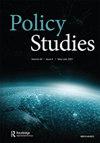Which civil society? State-run media and shaping the politics of NGOs in post-uprising Egypt
IF 2.3
4区 管理学
Q2 PUBLIC ADMINISTRATION
引用次数: 0
Abstract
This article explores the role of traditional, state-run media as tools for both, promoting policy, and providing feedback about non-governmental organizations (NGOs)-related policies in Egypt. It also gives insights into how media might contribute to shaping policy on NGOs in countries with similar systems of media governance. The study tests the social construction and policy design theory's “target population proposition” by conducting a thematic analysis of news articles on NGO Law 70 of 2017. It adds a new media studies perspective to Schneider and Ingram’s theory by exploring the framing effects of the media as mediators between governmental policy and target groups of that same policy. The findings confirm Schneider and Ingram’s theory in post-uprising Egypt. It delineates that state-run media variously frame policy rationales of Law 70 of 2017. Dichotomous framing was found to support the significant burdens imposed on, and the sub-rosa benefits granted to, NGOs by the new policy. Media frames also varied according to NGOs’ social construction and power level. This distinction in policy rationales draws the line between developmental NGOs and advocacy organizations whose agenda is perceived as a source of threat to the sovereignty, political independence, and national interests of the state.哪个公民社会?国家媒体和塑造非政府组织在起义后的埃及政治
本文探讨传统国营媒体在促进政策和提供非政府组织相关政策反馈方面所扮演的角色。它还深入探讨了在具有类似媒体治理体系的国家,媒体如何有助于形成针对非政府组织的政策。本研究通过对2017年《非政府组织法》第70号相关新闻的专题分析,检验了社会建构与政策设计理论的“目标人群命题”。它通过探索媒体作为政府政策和同一政策目标群体之间的调解人的框架效应,为施耐德和英格拉姆的理论增加了一个新的媒体研究视角。这些发现证实了施耐德和英格拉姆在埃及起义后的理论。它描述了国营媒体对2017年第70号法律的政策依据进行各种框架。发现二分法框架支持新政策对非政府组织施加的重大负担和给予的次要利益。媒体框架也因非政府组织的社会建构和权力水平而有所不同。这种政策依据上的区别区分了发展性非政府组织和倡导性组织,后者的议程被视为对国家主权、政治独立和国家利益的威胁。
本文章由计算机程序翻译,如有差异,请以英文原文为准。
求助全文
约1分钟内获得全文
求助全文
来源期刊

Policy Studies
PUBLIC ADMINISTRATION-
CiteScore
5.40
自引率
4.50%
发文量
34
期刊介绍:
These changes at the structural level of the global system have impacted upon the work of public organizations either directly or indirectly and have broadened the field of action in policy studies. It has five main areas of intellectual interest: 1.To broaden the lens of policy analysis through the publication of research which locates policy-making within a theoretical, historical or comparative perspective. 2.To widen the field of enquiry in policy analysis through the publication of research that examines policy issues in a British, comparative, international or global context. 3.To promote constructive debate on theoretical, methodological and empirical issues in policy analysis.
 求助内容:
求助内容: 应助结果提醒方式:
应助结果提醒方式:


